Samsung Galaxy S 6 and S 6 Edge: Preview
by Joshua Ho on March 26, 2015 9:00 AM EST- Posted in
- Smartphones
- Samsung
- Mobile
- Galaxy S6
- Galaxy S6 Edge
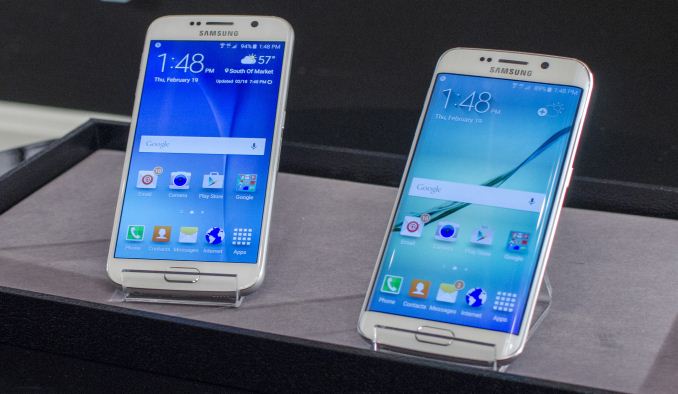
Yesterday we received our Galaxy S6 and S6 edge review units. We’re still working on the final review but I wanted to share some early results from both devices. For those that are unfamiliar with these two phones, the Galaxy S6 range represents the result of Samsung’s “Project Zero”. In fact, the phones seem to have the internal name of Zero, which can be seen in terminal, and the build properties of both devices. For Samsung, these phones represent their attempt at completely rethinking how Samsung makes phones. There is a strong emphasis on a new unibody design, which has no visible gaps or screws. Rather than the plastic that previous Samsung phones have been known for, the new design is composed of metal and glass. Samsung’s design team has been given unprecedented control throughout the process of making this phone and the result of this is a Galaxy phone that looks unlike anything else they’ve ever released.
Even if design is important, it isn’t enough to make the phone. Samsung has also outfitted the Galaxy S6 and S6 edge with their latest technologies, from a new AMOLED display to a new camera module. The specs for both phones can be seen below.
| Samsung Galaxy S5 | Samsung Galaxy S6 | Samsung Galaxy S6 Edge | |
| SoC | MSM8974ACv3 2.45 GHz Snapdragon 801 | Exynos 7420 2.1/1.5GHz A57/A53 | Exynos 7420 2.1/1.5GHz A57/A53 |
| RAM/NAND | 2GB LPDDR3 16/32GB NAND + microSD |
3GB LPDDR4-1552 32/64/128GB NAND |
3GB LPDDR4-1552 32/64/128GB NAND |
| Display | 5.1” 1080p SAMOLED HD |
5.1” 1440p SAMOLED |
5.1” 1440p SAMOLED, Dual Edge |
| Network | 2G / 3G / 4G LTE (Qualcomm MDM9x25 UE Category 4 LTE) | 2G / 3G / 4G LTE (Category 6 LTE) | 2G / 3G / 4G LTE (Category 6 LTE) |
| Dimensions | 142 x 72.5 x 8.1 mm, 145 grams | 143.4 x 70.5 x 6.8mm max, 138 grams | 142.1 x 70.1 x 7.0mm max, 132 grams |
| Camera | 16MP (5132 x 2988) Rear Facing with 1.12 µm pixels, 1/2.6" CMOS size, 31 mm (35mm effective), f/2.2 | 16MP (5132 x 2988) Rear Facing w/ OIS, f/1.9, object tracking AF | 16MP (5132 x 2988) Rear Facing w/ OIS, f/1.9, object tracking AF |
| 2MP Front Facing | 5MP Front Facing, f/1.9 | 5MP Front Facing, f/1.9 | |
| Battery | 2800 mAh (10.78 Whr) | 2550 mAh (9.81 Whr) | 2600 mAh (10.01 Whr) |
| OS | Android 4.4 w/TouchWiz |
Android 5 (64-bit) w/TouchWiz | Android 5 (64-bit) w/TouchWiz |
| Connectivity | 802.11a/b/g/n/ac 2x2 + BT 4.0 (BCM4354), USB3.0, GPS/GNSS, MHL, DLNA, NFC |
2x2 802.11a/b/g/n/ac + BT 4.1 (BCM4358), USB2.0, GPS/GNSS, NFC |
2x2 802.11a/b/g/n/ac + BT 4.1 (BCM4358), USB2.0, GPS/GNSS, NFC |
| Wireless Charging | N/A | WPC 1.1 (4.6W) & PMA 1.0 (4.2W) |
WPC 1.1 (4.6W) & PMA 1.0 (4.2W) |
| Fingerprint Sensor | Swipe | Touch | Touch |
| SIM Size | MicroSIM | NanoSIM | NanoSIM |
Both the Galaxy S6 and S6 edge have Samsung System LSI’s newest SoC, the Exynos 7420, which has a cluster of four Cortex A57s clocked at 2.1 GHz, and four Cortex A53s clocked at 1.5 GHz. Compared to the Exynos 5433 of the Galaxy Note 4, this brings a new 14nm LPE (low power early) process, an upgrade to LPDDR4 memory, and a Mali T760 GPU with two additional shader cores. Outside of the SoC, the new display is advertised to bring a higher 600-nit brightness and a higher 1440p resolution. The front and rear cameras are both different from the Galaxy S5 as well, although the rear camera sensor may be shared between the two as the camera sensors are of similar spec. For this preview, we’ll focus on the system performance and display of these new devices, but as one can see from the specification table there is far more to look at for the full review.
System Performance
For our system performance benchmarks we’ll start with our browser tests which can give a rough proxy for overall CPU performance.
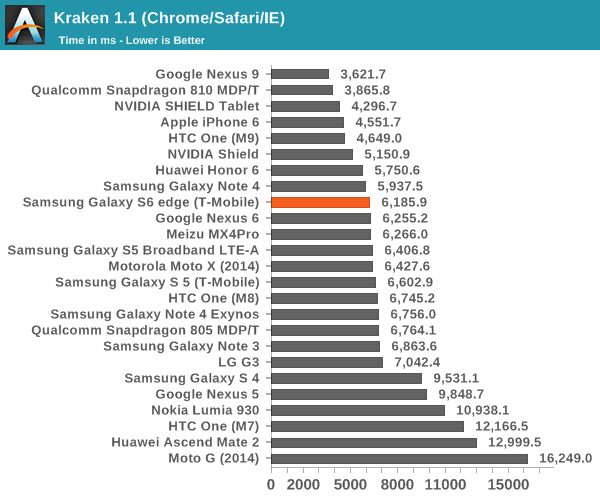
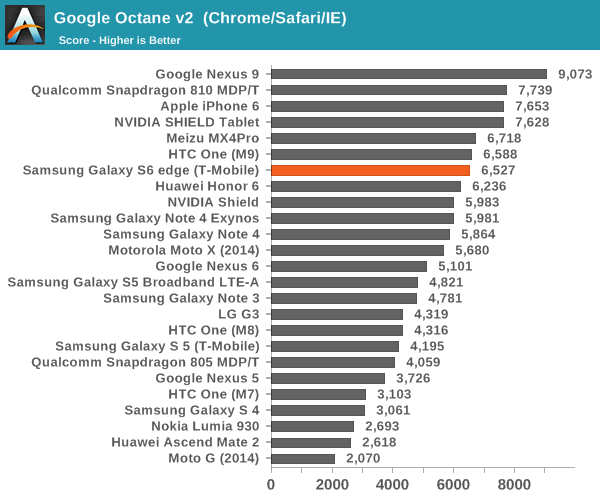
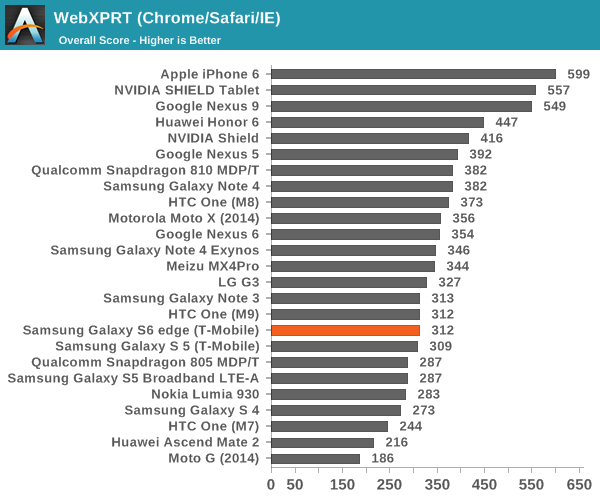
The Exynos 7420 is about on par with the Snapdragon 810 in these benchmarks. Strangely enough both tend to do worse than the Huawei Honor 6 in these tests, which clearly can't be correct. As we've previously discussed, the stock browser will often give far better results due to OEM and SoC vendor optimizations. As a part of our updates to the benchmark suite for 2015, we'll take a look at Basemark OS II 2.0, which should give a better picture of CPU performance in addition to overall device performance.
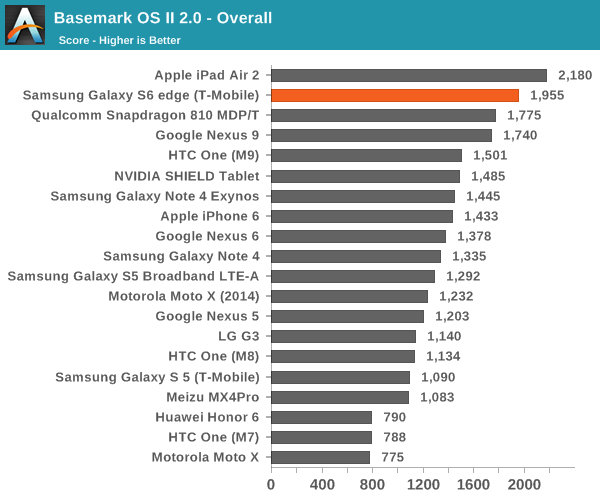
The browser benchmarks seem to hide some pretty enormous variability as the Galaxy S 6 edge (which is comparable to the Galaxy S 6) sets a new record among Android devices. The only challenger is the iPad Air 2, which uses the A8X SoC with three Enhanced Cyclone cores and the semi-custom GXA6850 GPU.
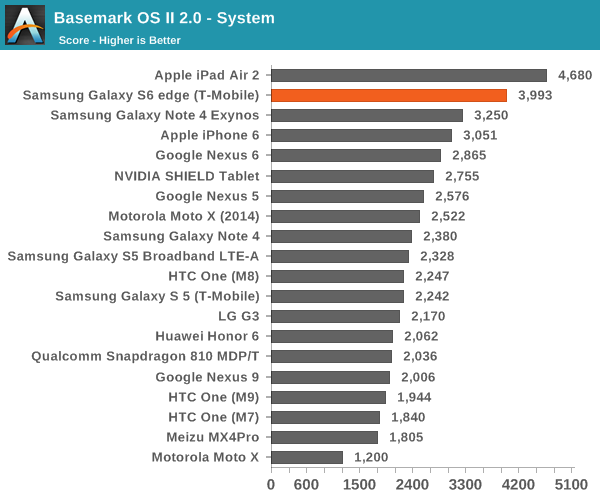
This system test contains a floating point and integer test, in addition XML parsing, which means that this test mostly stresses CPU and RAM. Interestingly enough, the Exynos 7420 pulls far ahead of both the Exynos 5433 and Snapdragon 810 in this test, and approaches the A8X. The difference between the 5433 and 7420 is likely a combination of the higher clocks on both the A57 and A53 clusters for the 7420 (1.9/1.3 on the 5433, 2.1/1.5 on the 7420), in addition to the ability to stay at a high 'overdrive' clock due to reduced leakage from the 14LPE process. The One M9 likely falls a bit short here due to HTC's governor settings restricting the use of all 8 cores simultaneously.
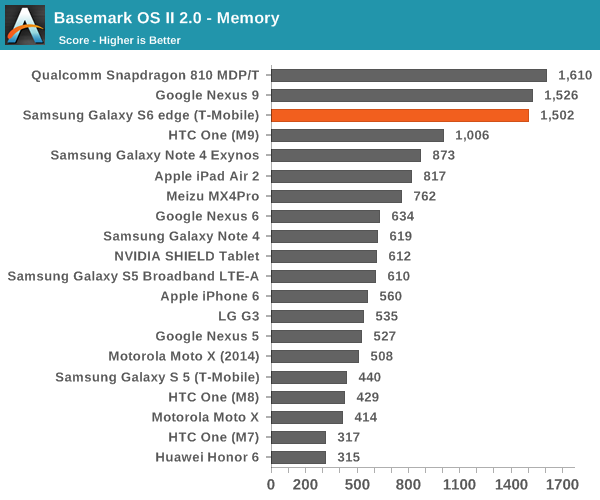
While one might guess that the memory test of 'Basemark OS II 2.0 - Memory' is of RAM, this is actually a test of the internal storage. Once again we see the S6 edge come close to leading the pack due to the use of the new UFS (Universal Flash Storage) standard. Casual examination reveals that the S6 edge has a queue depth of 16, and that it identifies itself with the rather cryptic model name of KLUBG4G1BD-E0B1.
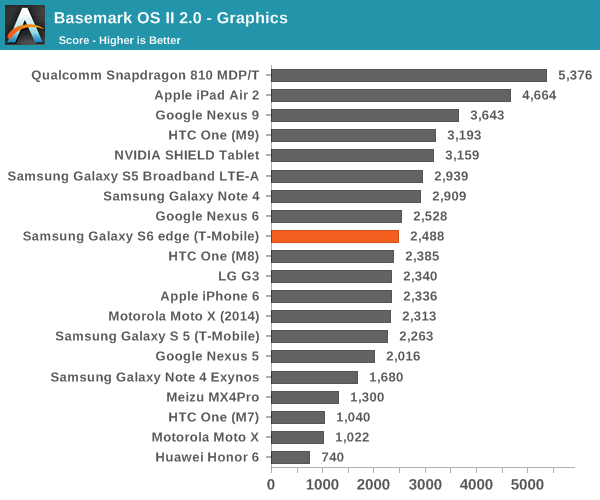
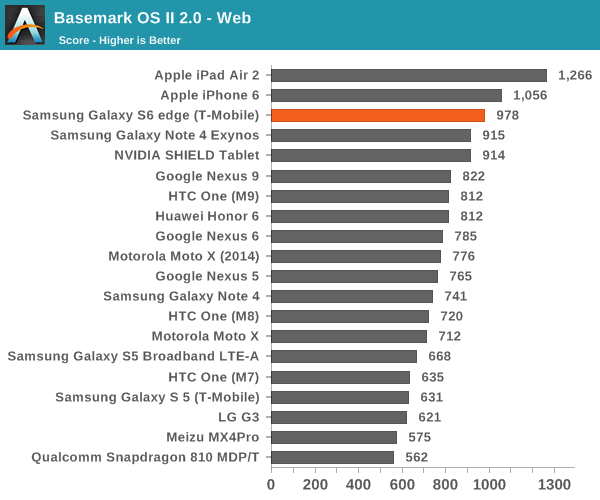
For the web test, it uses the built-in WebView rendering engine rather than Chrome and paints a distinctly different picture, especially because these tests are focused on HTML5 and CSS rather than JavaScript. Here we can see that the iPhone 6 and iPad Air 2 continue to hold their lead, but the Galaxy S6 is pretty much the king of the hill when it comes to Android devices.










200 Comments
View All Comments
tommo123 - Saturday, March 28, 2015 - link
no removable storage - stopped reading.maybe the next note will be worth a look
MercuryHero - Tuesday, April 14, 2015 - link
The benefit is that the in-built storage would be faster and more efficient than MicroSD would be, however it's disappointing how much the price premium is for the larger 64GB/128GB models.csavage - Monday, March 30, 2015 - link
Bought the sector 5 element case for a friend's birthday, about 2 months later he asked me for the reciept because the corner piece broke. I gave it to him and he contacted the company, they were not helpful at all and told him he would need to order a new piece to fix the case. He was then able to fix on his own and broke again within the first year. $140 dollars for a case should be under warranty for life, lets be honest most people have a phone for 2 years and would need a new case.very dissapointing cheap product waste of money...........
AnnonymousCoward - Monday, March 30, 2015 - link
Go whine somewhere else.very disappointing post waste of time..........
nathan119 - Monday, March 30, 2015 - link
Obviously those of you coming from an S5 or other galaxy phone with replaceable battery and microsd are miffed, but there are a lot of us that have been living without those features for a while. I haven't had those features since my Galaxy Nexus, but since then it's been the Nexus 4 and 5, and it honestly hasn't been a problem for me.I stream pretty much all my music, so even a 16gb nexus device has been fine. A 32gb Galaxy S6 would be plenty.
But as a loyal Nexus user, I find myself drawn to the S6 for a couple reasons. The Nexus 6 is just flat out too big, and with nothing in the 5" range on the horizon, what is a loyal Nexus user to do?
Couple things about the S6 have me interested. Awesome display. Awesome camera. In fact, as a Nexus faithful...having an awesome camera would be amazing, and by all accounts, this is one of the best around. Battery life also looks better than my Nexus 4 or 5, so even if it is smaller than last year, it's still a big upgrade for me.
And really, there aren't a lot of phones to consider. HTC is out, because the camera sucks. Note 4 and Nexus 6 are too big. One plus one...bad support, bad screen. So for everyone complaining about the lack of removable battery and microsd....what exactly are you moving to?
Kidster3001 - Wednesday, April 1, 2015 - link
Why, oh why, do you still use browsers to test CPU performance???? You are just testing the efficiency and optimization of the browser. Put an old version of Chrome on your Nexus 9 and see how well it does.... and comparing any browser on an Apple device against any browser on an Android device is just plain misleading.MercuryHero - Tuesday, April 14, 2015 - link
Obviously it doesn't make sense as a general measure of device performance or hardware performance, but browser speed is still an interesting comparison to make, as long as it's never claimed or inferred that it measures hardware or general device performance.jamesns - Thursday, April 2, 2015 - link
Brand New Unlocked Original Apple iphone 6 16gb, 64gb and 128GB , White , Black, Silver and GoldWhatsapp CHAT or Call : 00254703285513
Samsung Galaxy S6 edge and Samsung Galaxy S6 cost 500usd
Samsung galaxy s5 cost 400usd
Samsung note 4 cost 400usd
dummyaccount12345 - Saturday, April 11, 2015 - link
When is the full review coming out?!?!? Can't wait!anubis44 - Wednesday, April 15, 2015 - link
"and the result of this is a Galaxy phone that looks unlike anything else they’ve ever released."I beg to differ. The S6 looks exactly like the S4 to me. I wouldn't be able to tell the difference if my life depended on it. This is not a bad thing, however. Once a form factor is sufficiently refined, there shouldn't be any radical changes to the essential design. After all, human anatomy is the target, and human anatomy doesn't change over years or decades, so why should the product's essential egonomics, once they're pretty well perfect? Our ears, hands, and eyes aren't going to get bigger or smaller, so once the product is optimized for most people's ears, hands and eyes, radical changes to dimensions would be stupid, especially if you hope to be able to use the device in the same way, i.e. to be able to show others what you're looking at, to use as a telephone without a wireless earpiece, have a type-able keyboard, so you don't have to shout at the phone to try to do voice recognition, etc.